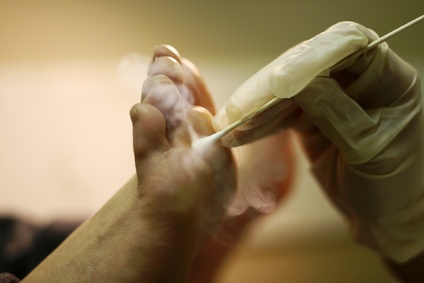Planters Warts and Mosaic Warts
Visit this
PICTURES OF RASHES PAGE
Planters warts are known by many names. For example, they can also be called a plantar wart, verruca, verruca pedis, and foot wart. This type of wart is often confused with calluses or corns – two other foot skin problems.
Verruca Wart Description and Symptoms
What makes these types of warts unique compared to most other types of skin warts is that these warts can cause considerable discomfort. In most cases, the warts are tender and this is because they grow into the skin. Most other warts grow outward. Verrucas are found on the sole of the foot, usually at the areas that see the most pressure. These areas include the heels, the balls of the feet, and the underside of the toes. The pressure that feet experience on a daily basis promotes the inward growth of this kind of wart.
Planters warts causes a sharp pain whenever pressure is applied to it or the surrounding area such as when standing, walking, running, jumping, etc. The discomfort can best be described as having a pebble in your shoe and walking on it. Even just pushing down lightly on the affected area with fingers is painful.

Other characteristics of these foot warts (which are fairly common) include the presence of one or several black dots (veins) in the center of the wart. The wart itself is white and hard and the surface rough. These foot warts may also appear to be gray or yellowish-brown in color. The boundaries of this wart are well defined. Foot warts can be small or cover large areas of the bottom of the foot. A single plantar wart can be up to one inch in size. Clusters of plantar warts can form are called mosaic warts.
Planters Warts Treatment
Planters warts commonly are found on individuals that often walk barefoot in public wet areas such as public showers, locker rooms, swimming pool areas, etc. Young teens are most often affected.
Treatment with over the counter products is usually not very effective for planter warts because most of the wart mass is below the surface of the skin. Other options such as cryotherapy, electrosurgery, use of laser treatments, or surgically cutting the wart out may be used.
Mosaic Warts
A mosaic wart is defined as a tightly packed grouping of many individual planter type warts. The grouping is often described as a plaque and is irregular in shape. The affected area also varies in depth, with some areas being higher whereas other skin areas are lower. The plaque can become very thick and dry. Because of the skin dryness, cracks can develop, making this skin condition even more uncomfortable. These clusters of warts bleed readily when abraded because of the many small capillaries that are present.
Because mosaics are planter like warts, many of the properties of plantar warts also apply.
Mosaic type warts are found mainly on the sole of the foot and sometimes on the hands and even other parts of the body. The mosaic plantar wart clusters can grow to be quite large. It is not usual for the mosaic foot wart to cover much of the bottom surface of the foot. The cluster may be up to several centimeters in diameter.
Treatment of mosaic foot warts is significantly more difficult than a solitary planter wart. This is especially true when the mosaic planter warts cover a large portion of the skin on the foot. Cryotherapy can be effective, but needs to be very aggressive and does not work completely in every patient. Surgical removal is not very effective because of the frequent reoccurrence of the warts in the scar tissue. Whatever treatment is used, several attempts to cure are often required to achieve complete elimination with no reoccurrence.
Additional information on other types of warts other than planter warts:
skin wart | common | face and filiform | finger | mosaic
